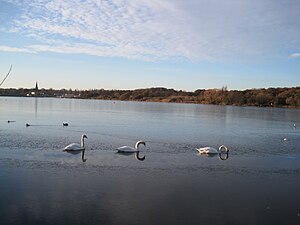51°30′N 0°5′W / 51.500°N 0.083°W

Greater London is one of the largest urban areas in Europe, with an area of 1,572 km2 (607 sq mi).[1] Its boundaries were set in 1965 when Greater London, which covers the 32 London boroughs and the City of London, was created. Almost two-thirds of it is green space and wetlands.[2] Its population according to the 2011 census was 8.17 million.[3]
Local nature reserve (LNR) is a statutory designation by local authorities which gives protection to wildlife habitats and natural features. It allows local authorities to apply local bye-laws to manage and protect sites.[4] The local authority must have a legal interest in the site, by owning or leasing it or having a nature reserve agreement with the owner.[5] As of January 2016, Natural England gives details of 144 local nature reserves declared by local authorities in Greater London, which are listed below.[6]
The largest site, at 97.31 hectares (240.5 acres), is Brent Reservoir, most of which is a Site of Special Scientific Interest for its breeding wetland birds, especially great crested grebes, and for its marsh plant life.[7] The smallest is Burnt Ash Pond at 0.13 hectares (0.32 acres), an old farm pond in the middle of a residential area.[8] The longest is Parkland Walk, a linear site of 7.2 kilometres (4.5 mi) along the route of an old railway line.[9] Perivale Wood is one of the oldest nature reserves in Britain. It has been managed by the Selborne Society since 1902, and was designated an LNR in 1974.[10] The newest LNRs are Coldfall Wood, Alexandra Palace and Park and Masons Field, all declared in 2013.[11][12][13] Several sites, including Camley Street Natural Park in Kings Cross and Frays Valley, are managed by the London Wildlife Trust.[14]
- ^ Watson, Jo (25 July 2009). "Access to Nature Regional Targeting Plan - LONDON" (PDF). Natural England. Archived from the original (PDF) on 14 July 2014. Retrieved 13 July 2014.
- ^ "London". Natural England. Archived from the original on January 12, 2008. Retrieved 28 May 2014.
{{cite web}}: CS1 maint: unfit URL (link) - ^ "2011 Census first results: London boroughs' populations by age by sex" (PDF). Greater London Authority. July 2012. Archived from the original (PDF) on 21 October 2014. Retrieved 6 June 2014.
- ^ "Why declare Local Nature Reserves?". Natural England. Archived from the original on 30 August 2014. Retrieved 28 May 2014.
- ^ "How are Local Nature Reserves declared?". Natural England. Archived from the original on 19 July 2014. Retrieved 28 May 2014.
- ^ Cite error: The named reference
NELondonwas invoked but never defined (see the help page). - ^ "Brent Reservoir citation" (PDF). Sites of Special Scientific Interest. Natural England. Archived (PDF) from the original on 24 September 2015. Retrieved 23 July 2014.
- ^ Cite error: The named reference
Burntwas invoked but never defined (see the help page). - ^ Cite error: The named reference
Parklandwas invoked but never defined (see the help page). - ^ Hall, Rae; Pedley, Andy. "The Selborne Society and Perivale Wood". London Parks Trust. Archived from the original on 6 June 2014. Retrieved 23 July 2014.
- ^ "Coldfall Wood". Local Nature Reserves. Natural England. 20 March 2014. Archived from the original on 13 April 2014. Retrieved 23 July 2014.
- ^ Cite error: The named reference
Alexandrawas invoked but never defined (see the help page). - ^ "Masons Field". Local Nature Reserves. Natural England. 10 March 2015. Archived from the original on 4 March 2016. Retrieved 21 April 2015.
- ^ "Find a nature reserve". London Wildlife Trust. Archived from the original on 23 July 2014. Retrieved 23 July 2014.
© MMXXIII Rich X Search. We shall prevail. All rights reserved. Rich X Search
